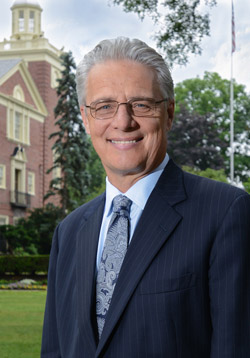
Download Image: Web
In the November issue, I indicated that my next several editorials would focus upon the recently adopted 2021 Strategic Plan. This month, I will develop in more depth the priorities that will be addressed with a next phase campus masterplan.
The 2014 Strategic Plan, Campus Masterplan and Campaign for a Greater Lycoming, articulated a vision for building a 21st- century physical campus. The investments that followed have strengthened the institution’s ability to deliver upon our mission as a residential liberal arts college and enhanced our capacity to compete for talented students and exceptional faculty and staff. Philanthropic support from alumni, friends of the College, and foundations, as well as decisions by the Board of Trustees to allocate resources from the plant fund, have made it possible to execute on the vision.
When the 2022-23 academic year opens, we will have completed substantial renovations to the College’s academic facilities (Lynn Science Center, Heim Science Building, Academic Center, and the new music building), its residence halls (Rich, Wesley, Crever, Skeath, and Asbury), and our athletic facilities (UPMC Field and the new stadium). In addition, the construction of the Krapf Gateway Center, along with the accompanying improvements to the streets on the southern end of campus, have forged a stunning new entrance to the College.
The 2021 Strategic Plan identifies three core objectives: growing revenue, stabilizing enrollment, and enhancing institutional reputation. It also describes upcoming enrollment challenges and an increasingly competitive market that will be shaped by an looming decline in the number of college-age students. It is now time to develop a next phase campus masterplan that identifies and prioritizes improvements to the physical campus that will be competitive assets in this environment.
The most important decisions involve residential halls that have not yet been renovated, the Lamade Gymnasium complex, and the Snowden Library. There are compelling reasons to pursue each project, and the process of a campus master plan will develop options and cost estimates. It will also establish priorities.
This next phase campus masterplan must include a vision for the College’s residential facilities that matches capacity to predicted enrollment, provides competitive housing options for juniors and seniors, and articulates the role of affinity housing. A plan for renovating East Hall is the most immediate priority; Williams Hall will need attention in the next few years. A decision about the future of Forrest Hall also needs to be made.
Having served as the home of Warrior athletics for more than 40 years, the Lamade Gymnasium complex is also in need of renovation. This project will strengthen the College’s ability to compete for students, as more than one-third of our incoming classes are recruited as student-athletes, and the facility serves as the competitive venue for volleyball, basketball, swimming, and wrestling.
The construction of a “learning commons” in the Snowden Library would present the College with an opportunity to enhance the role of the library, highlight our learning supports, and integrate information technology. This idea would transform the first floor of Snowden by bringing together services that support student success and information technology. The goal would be to strengthen student outcomes, improve retention, and signal to prospective students and families that Lycoming is committed to student success.
Investments in facilities that continue the College’s commitment to building a 21st-century campus are critical to the success of the 2021 Strategic Plan. They respond directly to the core objectives of stabilizing enrollment, enhancing institutional reputation, and growing revenue. They will strengthen Lycoming’s ability to deliver upon our mission and become assets in the competition to enroll talented students and recruit exceptional faculty and staff.
Kent C. Trachte, Ph.D., is the 15th president of Lycoming College.